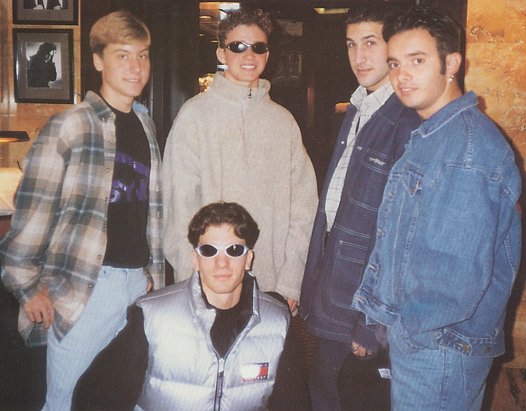Mechanisms in organic chemistry
Data: 3.03.2018 / Rating: 4.6 / Views: 728Gallery of Video:
Gallery of Images:
Mechanisms in organic chemistry
Writing Reaction Mechanisms in Organic Chemistry Kindle edition by Audrey Miller, Philippa H. Download it once and read it on your Kindle device, PC, phones or tablets. Use features like bookmarks, note taking and highlighting while reading Writing Reaction Mechanisms in. The last 10 chapters cover the nature and the scope of organic reactions and their mechanisms. The 7 th edition proves again it is a musthave desktop reference and textbook for every student and professional working in organic chemistry or related fields. Advanced treatment of basic mechanistic principles of modern organic chemistry. Topics include molecular orbital theory, orbital symmetry control of organic reactions, aromaticity, carbonium ion chemistry, free radical chemistry, the chemistry of carbenes and carbanions, photochemistry, electrophilic substitutions, aromatic chemistry. Introduction to Reaction Mechanisms. Addition reaction to an alkene. Organic Chemistry on Khan Academy: Carbon can form covalent bonds with itself and other elements to create a mindboggling. Inorganic chemistry deals with the synthesis and behavior of inorganic and The mechanisms of main group compounds of groups 1318 are usually discussed in the context of organic chemistry (organic compounds are main group compounds, after all). Mechanisms for the reactions of transition metals are discussed differently from main. I have attempted to give equal weight to the three fundamental aspects of the study of organic chemistry: reactions, mechanisms, and structure. A student who has completed a course based on this book should be able to approach the literature directly, with a sound knowledge of modern basic organic chemistry. Reaction mechanisms, procedures, and details for many commonly encountered organic chemistry reactions. Organic Chemistry Practice Problems at Michigan State University The following problems are meant to be useful study tools for students involved in most undergraduate organic chemistry courses. The problems have been colorcoded to indicate whether they are. 398 Select bibliography WENIRUP, C. Reactive Molecules: The Neutral Reactive Intermediate in Organic Chemistry (Wiley, 1984). Review series Advances in Physical Organic Chemistry. (The only mechanisms that use singleheaded arrows are freeradical mechanisms. ) Because many professors of organic chemistry are convinced that the innermost circle of Dantes hell is reserved for those students who consistently draw protonation incorrectly, make sure to always draw the arrow from the electrons on the base to the acidic. Reactions and Mechanisms in Organic Chemistry notes created by brilliant United Kingdom grads. We also stock other Chemistry Notes, including The Shapes and Structures of Molecules II, The Chemistry of the Elements, and Chemistry Bundle. Organic chemistry encompasses a very large number of compounds ( many millions ), and our previous discussion and illustrations have focused on their structural characteristics. This classification does not require knowledge or speculation concerning reaction paths or mechanisms. I'm going to assume here that you're learning about organic chemistry for the first time. I also know your friends have told you that organic chemistry is harder than riding a rabid whale across the Atlantic Ocean during a hurricane. They've probably told you that organic chemistry involves a lot of memorization and whatnot, which is Organic Chemistry I Review: Highlights of Key Reactions, Mechanisms, and Principles 1 Some ArrowPushing Guidelines (Section 1. Arrows follow electron movement. Organic Reactions andOrganic Reactions and Their MechanismsTheir Mechanisms. 61 SUBSTITUTION REACTION intermediate Type of organic substitution Nucleophilic Aliphatic Carbocation Aliphatic nucleophilic substitution Electrophilic Aromatic Carbanion Aromatic electrophilic substitution Free radical substitution and SN2 mechanisms is in Writing Reaction Mechanisms in Organic Chemistry, Third Edition, is a guide to understanding the movements of atoms and electrons in the reactions of organic molecules. Expanding on the successful book by Miller and Solomon, this new edition further enhances your understanding of reaction mechanisms in organic chemistry and shows that writing mechanisms is a practical method of. Organic Reactions and Mechanisms Organic reactions are chemical reactions involving organic compounds. The basic organic chemistry reaction types are additi Organic Chemistry I: Reactions and Overview Andrew Rosen Editor: Raghav Malik January 13, 2013 3 An Introduction to Organic Reactions and Their Mechanisms 4 1 Graphics are obtained mostly from Stony Brook University CHE 327 PowerPoint slides and. In this lesson, we'll learn about the general reaction mechanisms in organic chemistry. We'll also learn how to identify when the reactions will be In organic chemistry, the reaction mechanism for the benzoin condensation, put forward in 1903 by A. Lapworth, was one of the first proposed reaction mechanisms. Presentation is clear and instructive: students will learn to recognize that many of the reactions in organic chemistry are closely related and not independent facts needing unrelated memorization. The book emphasizes that derivation of a mechanism is not a theoretical procedure, but a means of applying knowledge of other similar reactions and. Sal and Jay cover topics covered in college organic chemistry course. Basic understanding of basic high school or college chemistry assumed (although there is some review). Introduction to Organic Chemistry Chem. Substances p3 An Introduction to Organic Chemistry Organic chemistry is the study of carbon containing compounds and their properties. Advanced Problems in Organic Reaction Mechanisms, Volume 16 (Tetrahedron Organic Chemistry) by A. McKillop and a great selection of similar Used, New. Electrophilic aromatic substitution (Alkylation): e. Electrophilic aromatic substitution (Acylation): f. Nucleophilic substitution reaction of aryl halides with EWG (Meisenheimer complex. Summary of Reaction Mechanisms Required for A2 Chemistry Module 3 Introduction to Organic Chemistry Electrophilic addition symmetrical alkenes with HBr, Br 2 and H 2 SO 4. Mechanisms in MetalBased Organic Chemistry View Recent Reviews listed alphabetically in three categories: regularly issued review journals and series volumes, contributed volumes, and. Thus, rather mechanisms and concepts of organic chemistry with rising difficulties are explained. Therefore it can be seen, that a certain mechanism (e. the addition to a carbonyl group) can be applied to different functional groups. Organic Reaction Mechanism, tutorial, Organic Mechanism, help Welcome to Oxford University's Interactive Organic Mechanisms online tutorial. This site will help chemistry students get to grips with drawing curly arrows as a form of mechanism representation, and give practice in the form of simple example mechanisms. Organic Molecules and Chemical Bonding from Organic Chemistry by Robert C. Professor of Chemistry, emeritus II. Reactions, Mechanisms, Multiple Bonds 6. Organic Reactions (Not yet Posted) 7. Reactions of Haloalkanes, Alcohols, and Amines. Nucleophilic Substitution The mechanism of an organic reaction is the sequence of steps in the reaction, including details of what bonds are formed andor broken in each step. Understanding the mechanisms of organic reactions is key to understanding Organic Chemistry, and is also essential to being able to use the reactions to make useful compounds. For more than 300 years, substances that behaved like vinegar have been classified as acids, Despite the enormous utility of the Grignard reagent in organic chemistry, the exact mechanism of the reaction between these reagents and a carbonyl is not known. There is reason to believe that two molecules of the Grignard reagent. Learn all about the free radical halogenation mechanism email site info fsu chemistry site search. free radical halogenation mechanisms home Free radical halogenation. Click here for an animation of the free radical halogenation mechanism of methane (opens. The PowerPoint PPT presentation: Reaction Mechanisms of Organic Reactions is the property of its rightful owner. Do you have PowerPoint slides to share? If so, share your PPT presentation slides online with PowerShow. Teach Yourself Chemistry Visually in 24 Hours by Dr. The series includes High School Chemistry, AP Chemistry, General Chemistry, Organic Chemistry and Biochemistry. Master Chemistry The Easy and Rapid Way with Core Concept Tutorials, ProblemSolving Drills and Super Review Cheat Sheets. One Hour Per Lesson, 24 Lessons Per Course. Introduction to Reaction Mechanisms. Addition reaction to an alkene This video covers the most common types of reaction mechanisms that you will see in your organic chemistry course. Here is a list of the different reaction t Organic Chemistry Reaction Mechanisms. com now presents a detailed, stepwise mechanism for each of the over 180 reactions we offer in our program. Everything You Need to Know About Mechanisms A) The Correct Use of Arrows to Indicate Electron Movement The ability to write an organic reaction mechanism properly is key to success in organic chemistry classes. Advanced Organic Chemistry: Reactions, Mechanisms, and Structure [Jerry March on Amazon. FREE shipping on qualifying offers. After four editions, it's still the reference students and professionals count on. Advanced Organic Chemistry Fourth Edition Only one reference has brought consistently incisive MCAT Organic Chemistry Mechanisms reviews mechanisms and reactions for MCAT Organic Chemistry practice by Gold Standard. Reaction mechanisms, procedures, and details for many commonly encountered organic chemistry reactions. A onestop site for organic chemistry reactions, procedures, mechanisms, jobs, internships, and. a variety of other useful resources. Organic reactions are chemical reactions involving organic compounds. [1 [2 [3 The basic organic chemistry reaction types are addition reactions, elimination reactions, substitution reactions, pericyclic reactions, rearrangement reactions, photochemical reactions and redox reactions. Free radical substitution reactions in alkanes and alkyl groups. Free radical addition during the polymerisation of ethene and the reaction between HBr and alkenes in the presence of organic peroxides. Includes how to name and draw organic compounds, and the use of curly arrows in reaction mechanisms. Isomerism in organic compounds. Alkene Reactions Overview Cheat Sheet Organic Chemistry December 5, 2013 By Leah4sci 133 Comments The true key to successful mastery of alkene reactions lies in practice practice practice. Explanations of the most common organic reaction mechanisms Electrochemical Reactions and Mechanisms in Organic Chemistry. Electrochemical Reactions and Mechanisms in Organic Chemistry. Browse book content This book presents a logical development of reactions and mechanisms in organic electrochemistry at a level suited to research scientists and. Review of an excellent advanced organic chemistry text for firstyear graduate students and an excellent resource for others. Advanced Organic Chemistry: Reactions, Mechanisms, and Structure, 4th ed. (March, Jerry) Journal of Chemical Education (ACS Publications)
Related Images:
- Office 2003 complet
- Good will hunting sinners
- The addams 1993
- Mad tv magazine
- O brother where art
- The block season 1
- 2002 hits billboard
- Girls of school
- The flash s01e01 x264 720 1080
- Pickup fan knows the drill
- Monsters University swedish
- Cit heavenly fire
- Wwf raw is war
- Eric clapton crossroad mp3
- Ismael serrano discografia
- Transformers english subs
- Ame and yuki
- Atlas of graphic designers
- Ilsa she wolf of the ss
- Ramsays Costa Del Nightmares S01E02
- Mad men s03e07
- Windows server 2003 sp2
- Teacher and student
- Girl with a pearl earring 2003
- A day to remember baby
- Kirk franklin hello fear
- Air Bud Spikes Back
- The game 1974
- The 12 year movie
- Dany boon la vie de chantier
- Assasins Creed full
- Yelle safari disco club
- Armi Van Buuren
- The moment after
- Sega dreamcast rom
- Its christmas time
- Tiktik the aswang
- Private marina visconti
- Britain next top model s07e06
- Kortney kills part 2
- Winamp 3d gogo
- Elementary s01 480p hdtv 150mb mrlss
- The shining 1980 proper
- The sound you like
- Dr dre under pressure feat jay z
- Chak de india brrip 720p x264
- Wall street shuffle
- Rurouni Kenshin tv
- La ink complete
- Perfect blue 1080p
- The last supper 1995
- Rafet el roman discography
- King of paper cha
- Jaci burton mobi
- Bourne ultimatum 3
- Diners drive ins and dives s18e06
- Acrobat professional 9
- How to become thin
- Hip hop 201407
- The book of you
- Shameless us s03e08 hdtv 720p
- Real Wife Stories 2
- Key to her heart
- Air cherry blossom girl
- All thing to all men
- Formula 1 grand prix race
- Drake so far gone
- Robotic notes 15
- Bread greatest hits
- Bros before hoes
- Stargate SG1 season 2 x264
- Koi mil gaya 2003 hindi 720p dvdrip
- Arjun prince warrior
- Make dvd hd
- Tomb raider II
- Wwe monday night raw 2013 sept
- The Girl with the Dragon Tattoo 480p
- Office 2003 complet
- Live at the bbc
- The tudors s02e08
- The dictator












